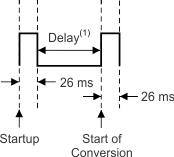SLOS887F September 2014 – June 2022 TMP112-Q1
PRODUCTION DATA
- 1 Features
- 2 Applications
- 3 Description
- 4 Revision History
- 5 Description (continued)
- 6 Pin Configuration and Functions
- 7 Specifications
-
8 Detailed Description
- 8.1 Overview
- 8.2 Functional Block Diagram
- 8.3 Feature Description
- 8.4 Device Functional Modes
- 8.5 Programming
- 9 Application and Implementation
- 10Power Supply Recommendations
- 11Layout
- 12Device and Documentation Support
- 13Mechanical, Packaging, and Orderable Information
Package Options
Mechanical Data (Package|Pins)
- DRL|6
Thermal pad, mechanical data (Package|Pins)
Orderable Information
8.4.1 Continuous-Conversion Mode
The default mode of the TMP112-Q1 device is continuous conversion mode. During continuous-conversion mode, the ADC performs continuous temperature conversions and stores each results to the temperature register, overwriting the result from the previous conversion. The conversion rate bits, CR1 and CR0, configure the TMP112-Q1 device for conversion rates of 0.25 Hz, 1 Hz, 4 Hz, or 8 Hz. The default rate is 4 Hz. The TMP112-Q1 device has a typical conversion time of 26 ms. To achieve different conversion rates, the TMP112-Q1 device makes a conversion and then powers down and waits for the appropriate delay set by CR1 and CR0. Table 8-5 lists the settings for CR1 and CR0.
| CR1 | CR0 | CONVERSION RATE |
|---|---|---|
| 0 | 0 | 0.25 Hz |
| 0 | 1 | 1 Hz |
| 1 | 0 | 4 Hz (default) |
| 1 | 1 | 8 Hz |
After a power up or general-call reset, the TMP112-Q1 device immediately begins a conversion as shown in Figure 8-7. The first result is available after 26 ms (typical). The active quiescent current during conversion is 40 μA (typical at 27°C). The quiescent current during delay is 2.2 μA (typical at 27°C).
